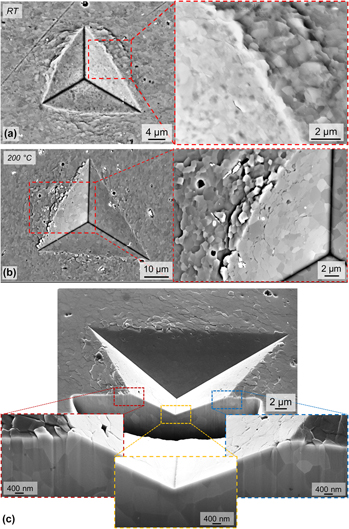Crossref Citations
This article has been cited by the following publications. This list is generated based on data provided by
Crossref.
Wheeler, J. M.
and
Michler, J.
2013.
Invited Article: Indenter materials for high temperature nanoindentation.
Review of Scientific Instruments,
Vol. 84,
Issue. 10,
Choi, In-Chul
Kim, Yong-Jae
Wang, Y. Morris
Ramamurty, Upadrasta
and
Jang, Jae-il
2013.
Nanoindentation behavior of nanotwinned Cu: Influence of indenter angle on hardness, strain rate sensitivity and activation volume.
Acta Materialia,
Vol. 61,
Issue. 19,
p.
7313.
Wheeler, J.M.
Maier, V.
Durst, K.
Göken, M.
and
Michler, J.
2013.
Activation parameters for deformation of ultrafine-grained aluminium as determined by indentation strain rate jumps at elevated temperature.
Materials Science and Engineering: A,
Vol. 585,
Issue. ,
p.
108.
Limbach, Rene
Rodrigues, Bruno P.
and
Wondraczek, Lothar
2014.
Strain-rate sensitivity of glasses.
Journal of Non-Crystalline Solids,
Vol. 404,
Issue. ,
p.
124.
Göken, M.
2014.
Moderne Methoden der WerkstoffprüFung.
p.
299.
Choi, In-Chul
Kim, Yong-Jae
Ahn, Byungmin
Kawasaki, Megumi
Langdon, Terence G.
and
Jang, Jae-il
2014.
Evolution of plasticity, strain-rate sensitivity and the underlying deformation mechanism in Zn–22% Al during high-pressure torsion.
Scripta Materialia,
Vol. 75,
Issue. ,
p.
102.
Merle, Benoit
and
Göken, Mathias
2014.
Bulge fatigue testing of freestanding and supported gold films.
Journal of Materials Research,
Vol. 29,
Issue. 2,
p.
267.
Wang, Zhijun
Guo, Sheng
Wang, Qing
Liu, Zhiyuan
Wang, Jincheng
Yang, Yong
and
Liu, C.T.
2014.
Nanoindentation characterized initial creep behavior of a high-entropy-based alloy CoFeNi.
Intermetallics,
Vol. 53,
Issue. ,
p.
183.
Liu, Y.
Hay, J.
Wang, H.
and
Zhang, X.
2014.
A new method for reliable determination of strain-rate sensitivity of low-dimensional metallic materials by using nanoindentation.
Scripta Materialia,
Vol. 77,
Issue. ,
p.
5.
Wheeler, J.M.
Armstrong, D.E.J.
Heinz, W.
and
Schwaiger, R.
2015.
High temperature nanoindentation: The state of the art and future challenges.
Current Opinion in Solid State and Materials Science,
Vol. 19,
Issue. 6,
p.
354.
Durst, Karsten
and
Maier, Verena
2015.
Dynamic nanoindentation testing for studying thermally activated processes from single to nanocrystalline metals.
Current Opinion in Solid State and Materials Science,
Vol. 19,
Issue. 6,
p.
340.
Maier, Verena
Leitner, Alexander
Pippan, Reinhard
and
Kiener, Daniel
2015.
Thermally Activated Deformation Behavior of ufg-Au: Environmental Issues During Long-Term and High-Temperature Nanoindentation Testing.
JOM,
Vol. 67,
Issue. 12,
p.
2934.
Koch, Susanne
Abad, Manuel D.
Renhart, Susanna
Antrekowitsch, Helmut
and
Hosemann, Peter
2015.
A high temperature nanoindentation study of Al–Cu wrought alloy.
Materials Science and Engineering: A,
Vol. 644,
Issue. ,
p.
218.
Merle, Benoit
Cassel, Detlev
and
Göken, Mathias
2015.
Time-dependent deformation behavior of freestanding and SiNx-supported gold thin films investigated by bulge tests.
Journal of Materials Research,
Vol. 30,
Issue. 14,
p.
2161.
Maier, Verena
Schunk, Christopher
Göken, Mathias
and
Durst, Karsten
2015.
Microstructure-dependent deformation behaviour of bcc-metals – indentation size effect and strain rate sensitivity.
Philosophical Magazine,
Vol. 95,
Issue. 16-18,
p.
1766.
Ctvrtlik, Radim
Al-Haik, Marwan S.
and
Kulikovsky, Valeriy
2015.
Mechanical properties of amorphous silicon carbonitride thin films at elevated temperatures.
Journal of Materials Science,
Vol. 50,
Issue. 4,
p.
1553.
Limbach, R.
Rodrigues, B.P.
Möncke, D.
and
Wondraczek, L.
2015.
Elasticity, deformation and fracture of mixed fluoride–phosphate glasses.
Journal of Non-Crystalline Solids,
Vol. 430,
Issue. ,
p.
99.
Primorac, Mladen-Mateo
Abad, Manuel David
Hosemann, Peter
Kreuzeder, Marius
Maier, Verena
and
Kiener, Daniel
2015.
Elevated temperature mechanical properties of novel ultra-fine grained Cu–Nb composites.
Materials Science and Engineering: A,
Vol. 625,
Issue. ,
p.
296.
Laurent‐Brocq, Mathilde
Béjanin, Estelle
and
Champion, Yannick
2015.
Influence of roughness and tilt on nanoindentation measurements: A quantitative model.
Scanning,
Vol. 37,
Issue. 5,
p.
350.
Limbach, R.
Winterstein-Beckmann, A.
Dellith, J.
Möncke, D.
and
Wondraczek, L.
2015.
Plasticity, crack initiation and defect resistance in alkali-borosilicate glasses: From normal to anomalous behavior.
Journal of Non-Crystalline Solids,
Vol. 417-418,
Issue. ,
p.
15.





